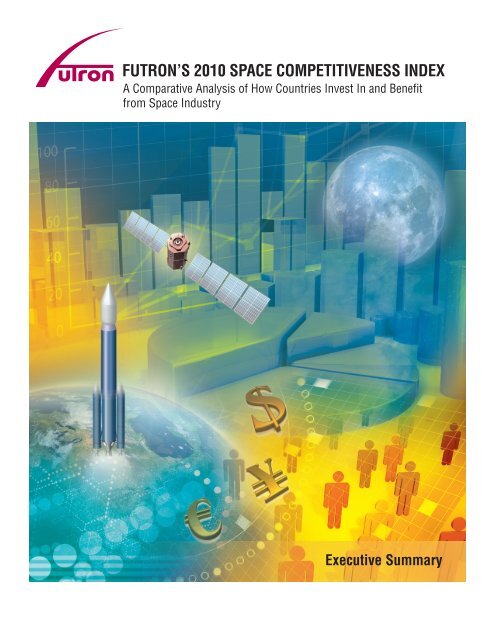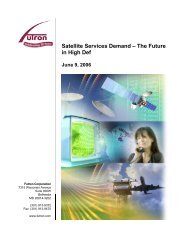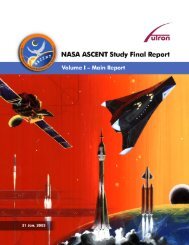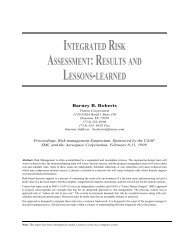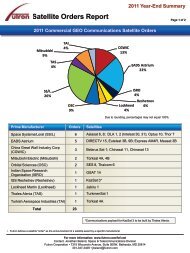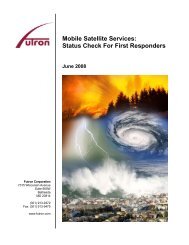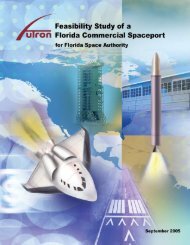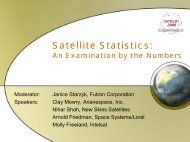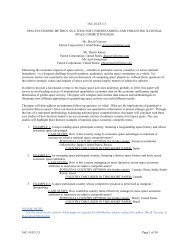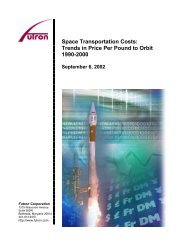futron's 2010 space competitiveness index - Futron Corporation
futron's 2010 space competitiveness index - Futron Corporation
futron's 2010 space competitiveness index - Futron Corporation
- No tags were found...
Create successful ePaper yourself
Turn your PDF publications into a flip-book with our unique Google optimized e-Paper software.
FUTRON’S <strong>2010</strong> SPACE COMPETITIVENESS INDEXA Comparative Analysis of How Countries Invest In and Benefitfrom Space IndustryExecutive Summary
FUTRON’s <strong>2010</strong> SPACE COMPETITIVENESS INDEX (SCI)A Comparative Analysis of How Countries Invest in and Benefit from Space IndustryEXECUTIVE SUMMARYSince the successful launch of Sputnik more than 50 years ago, we have lived in a world transformedby <strong>space</strong>. Space is practical, economic, and strategic. Countries that participate in <strong>space</strong> reap tangiblescientific, technical, and financial rewards that improve the lives of their citizens, increase their baseof knowledge, advance their productive capabilities, expand their range of economic activities, andenhance their geopolitical position. Nations active in <strong>space</strong> accrue strategic benefits over their peers—and nations that lead in <strong>space</strong> develop sustained advantages that underpin, complement, and augmenttheir leadership across all other dimensions of global commerce, technology, prestige, and power. Thisrealization has made <strong>space</strong> an arena for both international cooperation and competition.<strong>Futron</strong>’s <strong>2010</strong> Space Competitiveness Index is an analytical framework that defines, quantifies, andranks global <strong>competitiveness</strong> within the <strong>space</strong> industry. By measuring the underlying drivers ofeconomic advantage, the methodology is designed to assess the ability of a country to undertake <strong>space</strong>activities and evaluates their relative performance within a globally competitive market. With itsstrategic focus, <strong>Futron</strong>’s <strong>2010</strong> SCI builds upon the work conducted for our inaugural 2008 and 2009reports, as well as incorporating extensive feedback from clients and readers. The SCI goes beyond atypical economic assessment to consider the comparative <strong>space</strong>-related strengths, weaknesses,opportunities, and threats for each of the 10 countries examined. These country profiles were reviewedand vetted by industry experts. The countries identified as the top 10 leading <strong>space</strong>-faring nations in<strong>2010</strong> include: Brazil, Canada, China, Europe (treated as an integrated whole), India, Israel, Japan,Russia, South Korea, and the United States.Executives, policy makers, and thought leaders who seek to shape the future <strong>space</strong> landscape—andmaximize their competitive advantages within it—require a nuanced, methodical, and rigorouscomparative analysis of the dynamics and benefits of both competitive and collaborative postures.<strong>Futron</strong> <strong>Corporation</strong>, a premier provider of decision management solutions (DMS), created its annual,independent Space Competitiveness Index (SCI) expressly for this purpose. The SpaceCompetitiveness Index is a decision management tool. It offers decision makers, faced with financialchallenges and increasing global competition, an ongoing benchmark to continuously re-assess thecomparative landscape of <strong>space</strong> activity—and to contemplate its implications for their respectivegovernments, businesses, and organizations. Nations, militaries, companies, and other actors acrossthe world seek to derive maximum economic, security, diplomatic, technological, and scientificbenefits from <strong>space</strong>. <strong>Futron</strong> created the Space Competitiveness Index to contribute to theunderstanding of these complex strategic issues in a structured way.WHAT’S NEW IN FUTRON’S <strong>2010</strong> SPACE COMPETITIVENESS INDEX?In <strong>2010</strong>, <strong>Futron</strong> <strong>Corporation</strong> has built on its foundational 2008 and 2009 studies to provide an updatedand refined analysis of international <strong>space</strong> <strong>competitiveness</strong>. <strong>Futron</strong>’s <strong>2010</strong> Space CompetitivenessIndex examines the activities of leading <strong>space</strong>-participant nations from a fresh perspective, surveyingthree-year trends as a benchmark, and providing further discussion of their respective strengths,weaknesses, opportunities, and threats. The SCI provides a structured analysis of international <strong>space</strong><strong>competitiveness</strong> by measuring 50+ individual metrics across three underlying dimensions of<strong>competitiveness</strong>: government, human capital, and industry. Using this framework, <strong>Futron</strong> offers acomparative assessment of 10 nations: Brazil, Canada, China, Europe (viewed as a single entity),India, Israel, Japan, Russia, South Korea, and the United States (U.S.).1<strong>Futron</strong> <strong>Corporation</strong>
<strong>Futron</strong>’s <strong>2010</strong> Space Competitiveness Index (SCI) · Executive Summary<strong>Futron</strong>’s <strong>2010</strong> SCI expands its analysis of each country, providing added data, where applicable, onnational <strong>space</strong> assets, infrastructure, budget, and commercial sector revenues. This enhanced focus onthe 10 leaders is balanced by a discussion of five emerging <strong>space</strong> actors spanning diverse regions ofthe world: Australia, Iran, Singapore, South Africa, and Ukraine.In order to provide the most current and relevant information on key industry verticals, <strong>Futron</strong> also isintroducing an innovative delivery system for its detailed segment analyses. In previous versions ofthe SCI, segment analyses were released within the full report. In <strong>2010</strong>, purchasers of the full reportwill receive segment analyses throughout the year, totaling five in all. This rolling delivery offocused segment analyses will provide an up-to-the-minute view of global competitive dynamicswithin the following market areas:• Civil Space Exploration• Military Space• Positioning, Navigation, and Timing (PNT)• Remote Sensing• Space Technology Capability Base<strong>Futron</strong> <strong>Corporation</strong> is pleased to announce that the extensive full data set used to produce the <strong>2010</strong>SCI also is available. For further details, please visit our website at www.futron.com.KEY SPACE COMPETITIVENESS THEMESGlobal <strong>space</strong> activity drives a substantial economic engine, fosters national pride, and enhancesmilitary power. Some nations invest in <strong>space</strong> for the domestic esteem and international respectassociated with technological advances and satellite launches. Others focus more on the social benefitsderived from communications services, imagery, and applied sciences. Militaries also have longrealized the force multiplication effect of <strong>space</strong> assets, including secure communications,reconnaissance, force tracking, and the remote coordination and operation of war-fighting assets. Yetincreasingly, military <strong>space</strong> is interwoven with civilian and commercial <strong>space</strong> systems andinfrastructure—adding a new layer of complexity to governmental decision-making, nationalindustrial policy, and the participation of the private sector within the <strong>space</strong> sector. Moreover,whatever the purpose of <strong>space</strong> investment, it is enabled by a common denominator: human capital.Knowledge, skills, and expertise ultimately define the leading edge of <strong>space</strong> activity. In a world wheretalent is mobile, the ability to educate, attract, retain, and continuously enrich a base of skilledprofessionals is a growing determinant of which nations and actors lead in <strong>space</strong> <strong>competitiveness</strong>.While nations invest in <strong>space</strong> targeting different outcomes, the overall theme of <strong>space</strong> <strong>competitiveness</strong>is linked to national policy, national security, educational infrastructure, and economic strength.Together, the civilian, military, and commercial <strong>space</strong> sectors focus the broader <strong>space</strong> discoursearound key questions such as the relative competitive position of traditional <strong>space</strong> leaders; the role ofemerging <strong>space</strong> powers; and the aims of newer or smaller <strong>space</strong> participants. This study seeks toaddress pivotal and timely strategic questions about <strong>space</strong> power and <strong>competitiveness</strong>:• How does <strong>space</strong> <strong>competitiveness</strong> impact larger socio-economic trends?• Will the worldwide economic slowdown alter government and enterprise <strong>space</strong> plans?• How will the recent changes in the United States civil <strong>space</strong> program affect U.S. competitivetrajectory over the next five years?• What will be the strategic interplay among the three traditional, and current, leading <strong>space</strong>actors: the United States, Europe, and Russia?© <strong>2010</strong>2
• As Japan continues to implement its comprehensive Basic Space Law reforms, will it convertadministrative momentum into more pronounced regional <strong>space</strong> leadership?• Is China on track to achieve the ambitious <strong>space</strong> goals it has set for <strong>2010</strong> and 2011?• Will Indian investments in new launch and satellite platforms result in significanttechnological advances?• Will South Korea rebound from its failed launch attempt to conduct its first successful orbitalmission, reshaping the Asian <strong>space</strong> dynamic?• Will Canada’s military <strong>space</strong> policy refresh lead to closer alignment with the United Statesand Europe, or instead increase investment in independent capabilities?• Will Israel develop the political consensus to make larger <strong>space</strong> investments in order toconvert its niche strengths into an expanded international presence?• Will Brazil translate its current review of <strong>space</strong> plans into concerted national action?• Will emerging <strong>space</strong> participants such as Australia, Ukraine, and others surge to displace anyof the current leading nations?• As Iran builds on the success of its first orbital launch, will it disrupt the current <strong>space</strong>landscape, or be open to international collaboration and partnership?• What are the economic consequences of a commercial <strong>space</strong> environment developed bymultiple international providers of key technologies, systems, and services?To provide practical insight into these strategic questions, <strong>Futron</strong> <strong>Corporation</strong> is pleased toprovide this <strong>2010</strong> update of its Space Competitiveness Index. Some top-level findings of our SCIare provided below.SUMMARY HIGHLIGHTS• Brazil has begun to renew government focus on <strong>space</strong> activity, but it remains to be seen whether apolicy refresh will sustain the country’s position as the regional <strong>space</strong> leader.• Canada’s nuanced strategic balancing among domestic and international <strong>space</strong> programs,priorities, and partnerships continue to yield key <strong>competitiveness</strong> advantages.• China remains a leading <strong>space</strong> actor, but the country has recently experienced slight declines inrelative <strong>competitiveness</strong> due mainly to comparatively fewer <strong>space</strong> missions.• European <strong>competitiveness</strong> has risen slightly due to more cohesive policy as well as sustainedindustry performance.• India’s increased civil <strong>space</strong> funding, updated policy commitments, and targeted commercialoutreach continue to maximize its strengths.• Israel continues to play important niche roles in the optical equipment and small satellite markets,but lacks global commercial scale, and is inhibited by a lack of clear government commitment toits national <strong>space</strong> program.• Japan continues to show strong performance as its recent government reforms filter through to itsindustrial base.• Russia has benefited from updated government policy, increased transparency, formalizedinternational partnerships, and ongoing status as the world leader in number of annual launches.• South Korea maintains steady <strong>space</strong> investment and plans a second orbital launch attemptfollowing its abortive Korea Small Launch Vehicle (KSLV-1) flight in 2009.3<strong>Futron</strong> <strong>Corporation</strong>
<strong>Futron</strong>’s <strong>2010</strong> Space Competitiveness Index (SCI) · Executive Summary• The United States (U.S.) remains the current leader in <strong>space</strong> <strong>competitiveness</strong>, but its relativeposition continues to decline against the increasing capabilities of other <strong>space</strong>-participant nations.• International <strong>space</strong> collaboration is taking shape as a concerted national <strong>competitiveness</strong> strategy,especially among smaller actors.• Three distinct <strong>competitiveness</strong> tiers are clearly emerging, with especially intense competitionwithin the middle tier.<strong>2010</strong> SPACE COMPETITIVENESS INDEX – HISTORIC TRENDSIn addition to providing a framework for analyzing current <strong>competitiveness</strong>, <strong>Futron</strong>’s <strong>2010</strong> SCIequips decision makers with the ability to look at trends over time. The refined <strong>2010</strong> SCI provides acomprehensive benchmark from which to view the industry going forward, and <strong>Futron</strong> plans tocontinue its efforts to accurately measure and characterize the importance of <strong>space</strong> economics.This said, in order to put the results of the <strong>2010</strong> Space Competitiveness Index in perspective, <strong>Futron</strong>has also analyzed <strong>space</strong> trends over the last decade based on <strong>space</strong>craft manufacturing and orbitallaunch activity, as seen below. Additional historic data, including year-on-year trends, are alsoincluded in the full report.ORBITAL LAUNCH AND SPACECRAFT MANUFACTURING TRENDS, 2000-2009629 Successful Orbital Launches 1,027 Spacecraft Manufactured<strong>2010</strong> SPACE COMPETITIVENESS INDEX – FULL REPORT OUTLINEThe full report version of <strong>Futron</strong>’s <strong>2010</strong> Space Competitiveness Index features approximately120 additional pages of research and analysis including:• An Introduction offering insight into the SCI concept, purpose, methodology and structure.• Expanded country-by-country profiles for each nation’s <strong>space</strong> assets and efforts. These includea review of key events in 2009, and a look forward to developments expected in <strong>2010</strong>. Eachcountry overview includes a strengths, weaknesses, opportunities, and threats (SWOT) analysis.• An examination of five nations emerging in <strong>space</strong> <strong>competitiveness</strong>.• A discussion of cross-cutting segmentation themes shaping the <strong>space</strong> <strong>competitiveness</strong> discourse.• Five updated and in-depth segment analyses to be emailed to report providers throughout theyear on a rolling basis:© <strong>2010</strong>4
‣ Civil Space Exploration‣ Military Space‣ Positioning, Navigation, and Timing (PNT)‣ Remote Sensing‣ Space Technology Capability BaseIn addition, <strong>Futron</strong> <strong>Corporation</strong> is pleased to announce that the extensive data set used to produce the<strong>2010</strong> SCI is also for sale. For further details, please visit our website at www.futron.com.ABOUT FUTRON<strong>Futron</strong> <strong>Corporation</strong> is a premier provider of decision management solutions that enhance our clients’ability to make complex choices. We collaborate with our customers to remove the guesswork fromdecisions by qualitatively and quantitatively evaluating future outcomes to ensure optimal results. Ouranalytic models, methodologies, and data repositories transform information into intelligence. Ourmultidisciplinary, world-class team offers comprehensive knowledge of the aero<strong>space</strong>, satellite, andtelecommunications industries, with deep experience in statistical analysis, competitive assessments,forecasting, and strategy. In business since 1986, <strong>Futron</strong> has a staff of some 100 experts, includingpolicy analysts, management leaders, economists, regulatory specialists, PhDs, and engineers. <strong>Futron</strong>is headquartered in Bethesda, Maryland with offices in Houston, Texas and Hampton, Virginia.<strong>Futron</strong> <strong>Corporation</strong>’s Space & Telecommunications Division provides strategic market andtechnology advising services to <strong>space</strong>, telecommunications, and general business enterprises.• We combine technical and policy expertise with strategic depth to produce sophisticateddecision management solutions for the highest levels of commercial and public sectordecision-making.‣ Leading-edge, proprietary methodologies for data modeling, trend analyses, andforecasting‣ Comprehensive in-house information resources, databases and industry contacts‣ Extensive experience with government, military, and commercial clients• We enable decision makers to anticipate market and technology trends by understanding thecomplex interplay between government needs and commercial markets.‣ Multiple industry-cited studies examining strategic and tactical <strong>space</strong> technologies onbehalf of military, government, and commercial clients‣ Competitive industrial base and technology profiles‣ Strengths-Weaknesses-Opportunities-Threats (SWOT) analyses‣ Political-Economic-Social-Technological (PEST) analyses‣ Scenario development• We combine the agility of a small firm with a broad strategic and international perspective ofthe <strong>space</strong>, satellite, telecommunications, and security landscape to ensure commercial andgovernment leaders make the best-informed decisions possible.‣ Nuanced understanding of the commercial, government, and military sectors, refined over20 years offering premier decision support management services in the public and privatearenas‣ Identification of areas and avenues for cooperation among government, military, andcommercial actors‣ Objective perspective to pinpoint unaddressed strategic needs and recommend solutions5<strong>Futron</strong> <strong>Corporation</strong>
<strong>Futron</strong> <strong>Corporation</strong>7315 Wisconsin Avenue, Suite 900WBethesda, MD 20814www.futron.com • 1.800.807.4927ISO 9001 RegisteredCopyright © <strong>2010</strong> by <strong>Futron</strong> <strong>Corporation</strong>, All Rights Reserved.This publication may not, in whole or in part, be reproduced, copied, photocopied, translated orconverted to any electronic format without prior written consent from <strong>Futron</strong> <strong>Corporation</strong>.Unauthorized distribution or use of this report is prohibited.


